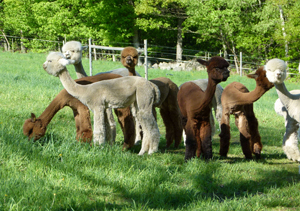They’re sexy and they know it

Mother Nature was toying with us yesterday on our last scheduled shearing day of 2013. I got back from dropping the boys off at school and pulled into the Arena’s parking lot here at the farm only to see snow flakes hitting the roof of our car. Needless to say, I was not amused. While it was just a momentary flurry that amounted to nothing, it was symbolically huge. While it has become almost tradition to have either a heat wave before we shear (last year it hit the 90s here…in April) or to have a cold snap immediately after we are shorn, with temps routinely in the upper 40s yesterday during the day and then hitting close to freezing last night, that was well…a new low. Sorry. Too many donuts the day before leads to bad punning. And to think that I was only worried about the calories?
Cold weather aside, we pressed forward at an excellent pace throughout the day yesterday. With the the two lower barns previously shorn, we didn’t have to pause to haul anyone up or down the hill and by 4:30 yesterday afternoon, all of the remaining critters had their new spring haircuts and we had 69 more blankets to add to the Arena’s fleece room. Shearer extraordinaire and all around good guy, Matt Best, was as always steady as can be. I’m always impressed that people who shear for a living can do that work virtually non-stop for three months. The poor bastards have at least another 6 weeks to go after us and we’ll be merely a blip on the screen in Matt’s final tally. My back hurts just thinking about it. We feel knackered this morning after finishing up yesterday and that was with a 10 day break in between days 2 and 3 for us. As Matt’s assistant, Ethan Hopkins, pointed out yesterday though: it probably comes down to conditioning and expectations. Those who do that sort of work 6 days a week learn to pace themselves and calibrate their bodies to the rhythm of it all. Though even Mat admitted that it was nice to come back 10 days later and just shear mostly production females, with the show critters and the Herdsires having been taken care of earlier. For the record it was 216 total alpacas that were shorn here over the course of all three days. By the way, the revelation-of-the shearing-session has to go to my wife and partner. Jennifer had the truly inspired idea to bring our electric leaf vacuum up from the house so that the we could use it to quickly clean up the two alternating shearing stations in between laying animals down. It worked as well as one of those fancy power vacuum systems that’s hung from the ceiling or wall and routed to a dumpster outside through a duct but was much easier to set up — there was no setup — and definitely cost only pennies by comparison. The mess at the end of the day, especially compared to years past, was almost non-existent. In any case, while you can of course draw your own conclusions as to our physical fortitude, for our part we are already planning on scheduling shearing with Mr. Best the same way for 2014: 2 days on, then 5 to 10 days off followed by a final day of shearing. If it ain’t broke…
With a hard frost in the forecast for last night, we did take pity on our big group of shorn juvenile females yesterday evening. The little girls had been locked out on pasture since last Friday, learning what it means to truly be a (mostly) grown up alpaca at CCNF. From experiencing the joys of a rain storm in an open paddock, to the black flies that are ubiquitous this time of year here in New England, they had already gotten a feel for most of the spectrum. We didn’t have the heart to leave them out there shivering last night though, just 10 days after they got their fleeces taken off. So as I was off picking Sam up from his lacrosse game, Jen went out and opened the gate from the lower paddock where they’ve been grazing and living beneath the stars. After a little urging from her, she got them all to rush back up towards the welcome shelter of the Main Barn. Though the thermometer on the car this morning at 6 AM seemed to show that the temperature never in fact went below freezing, I’m sure that the girls were happy to snuggle up inside nonetheless. I know we definitely slept better knowing they were in there too!
With the rain of last week, the pastures here have really come alive as well after more than a month of being in limbo. Now that the entire herd is shorn here, we have more pasture management options and in the coming days we will start to rotationally graze more of the outer paddocks using large feed groups of 30+ animals. The beautifully simple idea being to let a high concentration of alpacas graze a given paddock for 3 to 5 days before then moving them onto another, while the one that they were first on, regrows and recovers. We don’t have quite enough acreage here, with our herd size, to be able to practice true management-intensive grazing throughout the entire growing season but at least usually in May and and good chunk of June (if their is rain), we get to pretend that we’re grass-based farmers. For the time being at least, the grass is green and lush and springtime at CCNF is in full swing…
Follow me on Twitter @CCNFalpacas
